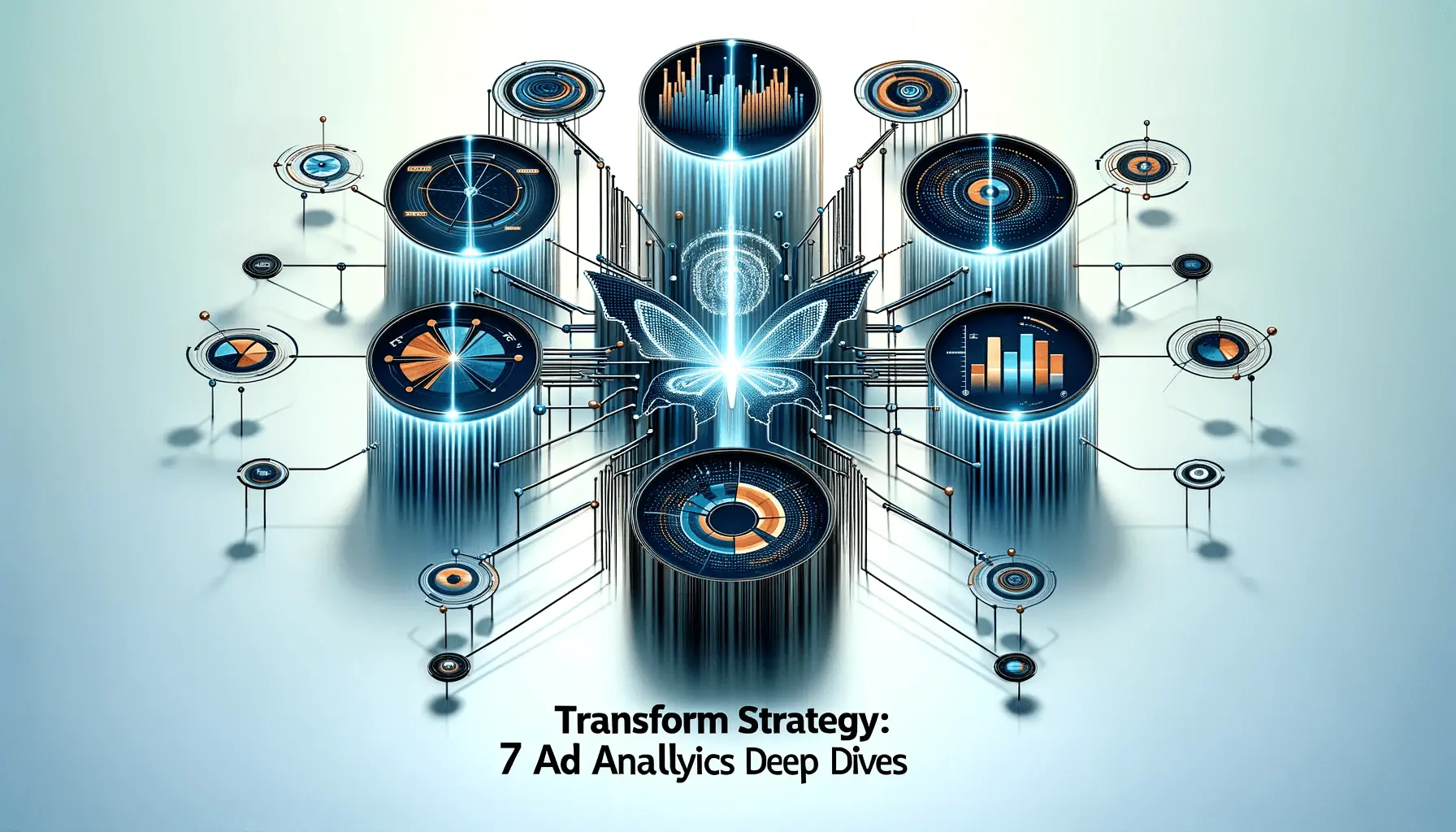In the present competitive online scenario, it is crucial to understand your LinkedIn ad analytics to evaluate your campaign performance.
With a closer look at ad analytics, you can transform your marketing strategy, optimize your campaigns, and achieve better outcomes.
Let’s explore the key metrics that provide meaningful insights into your LinkedIn ads.
- Understanding Key Metrics in LinkedIn Ad Analytics
- Advanced Targeting Strategies for LinkedIn Ads
- Optimizing Ad Creatives for Better Engagement
- Budgeting and Bidding Tactics for Optimal ROI
- Measuring and Analyzing LinkedIn Ad Performance
- Final Thoughts: Elevating Your LinkedIn Ad Campaign with Data-Driven Insights
- Frequently Asked Questions About LinkedIn Ad Analytics
Understanding Key Metrics in LinkedIn Ad Analytics
To effectively evaluate your LinkedIn advertising efforts, it’s essential to comprehend the fundamental metrics that reflect your campaign’s performance.
These metrics serve as indicators of how well your ads are resonating with your target audience and where improvements can be made.
Impressions: Measuring Ad Visibility
One of the key measures to track is ImpressionsThe number of times an ad is displayed to users on LinkedIn..
It indicates how frequently your LinkedIn ad is shown to users.
A higher number of impressions suggests your ad is gaining visibility and reaching a broader audience.
Clicks: Tracking User Interest
Another significant metric is Clicks, which represents the number of times users have clicked on your ad.
Tracking clicks helps determine the level of interest your ad generates among viewers.
Click-Through Rate (CTR): Evaluating Ad Effectiveness
The Click-Through Rate (CTR) is calculated by dividing the number of clicks by the number of impressions and multiplying by 100 to get a percentage.
A higher CTR indicates that your LinkedIn ad content is engaging and relevant to your audience.
Conversion Tracking: Measuring Ad Impact
Beyond basic engagement metrics, monitoring Conversion TrackingA method to measure the actions users take after interacting with an ad, such as form submissions or purchases. is essential.
This refers to tracking user actions after clicking your ad, such as:
- Filling out a form
- Downloading a file
- Making a purchase
By analyzing conversion tracking, you can assess the direct impact of your LinkedIn ad analytics on business goals.
Cost Metrics: Optimizing Your Ad Budget
Managing ad spend efficiently is crucial.
Understanding key cost metrics enables better budgeting decisions:
- Cost Per Click (CPC): Determines the amount spent per ad click.
- Cost Per Thousand Impressions (CPM): Indicates the cost for every thousand ad impressions.
- Cost Per Lead (CPL): Helps evaluate the cost of acquiring potential customers.
Tracking these metrics ensures your LinkedIn ad budget is optimized for maximum returns.
By keeping a close eye on these critical statistics in LinkedIn ad analytics, you can make informed decisions to refine your strategy, improve campaign performance, and achieve cost-effective results.
Key metrics in LinkedIn Ad Analytics help you measure performance, refine targeting, and optimize your ad strategy for better engagement and ROI.
Advanced Targeting Strategies for LinkedIn Ads
In order to maximize your return on investment (ROI) from your LinkedIn ad analytics, it is essential that you utilize advanced targeting strategies.
These techniques allow you to focus on a more precise audience, driving engagement and improving campaign performance.
Let’s explore some of the most effective strategies.
Utilizing LinkedIn’s Demographic Targeting Features
LinkedIn provides an abundance of demographic data that you can leverage to refine your ad targeting.
By focusing on specific attributes, you can ensure your LinkedIn ads reach the most relevant professionals.
- Job Title and Function: Targeting by job title allows you to focus on specific roles, while job function targeting helps you reach broader departments. Adding seniority levels can further segment your audience to target key decision-makers.
- Industry and Company Size: Ads targeted to specific industries or company sizes ensure that your message reaches businesses aligned with your ideal customer profile.
- Skills and Interests: Users can be targeted based on the skills listed in their profiles or their membership in industry-related groups, connecting you with professionals who have specific expertise relevant to your offerings.
Through proper utilization of these LinkedIn ad analytics features, you can enhance campaign efficiency by achieving more precise engagement and higher conversion rates.
Utilizing Matched Audiences and Retargeting Strategies
Matched Audiences on LinkedIn enables you to target audiences that have already interacted with your business, fostering deeper connections and increasing the likelihood of conversion.
- Website Retargeting: This strategy allows you to target LinkedIn members who have visited your website, enabling you to reconnect with potential leads using content tailored to their interests.
- Contact Targeting: By importing your existing contact lists, you can present targeted ads to your current leads or customers, strengthening brand recall and engagement.
- Account Targeting: Direct your campaigns toward specific businesses by uploading a list of target accounts. This approach, often used in Account-Based Marketing (ABM), helps reach high-value prospects effectively.
By implementing these retargeting techniques, your advertisements will be seen by an audience already familiar with your brand, increasing the chances of conversions.
Carrying Out Account-Based Marketing (ABM) on LinkedIn
Account-Based Marketing (ABMAccount-Based Marketing; a B2B marketing strategy that focuses on targeting high-value business accounts rather than individual leads.) is a strategic approach that focuses resources on engaging specific high-value accounts.
LinkedIn’s advanced targeting capabilities make it the ideal platform for executing ABM strategies.
- Personalized Content: Create customized ad content that speaks directly to the unique needs and challenges of each target account, demonstrating a deeper understanding of their business.
- Multi-Touch Campaigns: Engage decision-makers across multiple touchpoints within the target organization, ensuring consistent and relevant messaging throughout the buyer journey.
- Performance Measurement: Continuously monitor engagement and conversion metrics for each account to gauge campaign success and refine strategies accordingly.
By implementing ABM on LinkedIn, you can create highly targeted campaigns that resonate with specific accounts, fostering stronger engagements and increasing ROI.
Incorporating these advanced targeting techniques into your LinkedIn ad analytics strategy can significantly enhance the effectiveness of your campaigns, ensuring your messages reach the right audience and drive meaningful results.
Utilizing advanced targeting strategies, such as demographic targeting and retargeting, allows you to reach the most relevant audience and increase conversion rates effectively.
Optimizing Ad Creatives for Better Engagement
For LinkedIn ads, designing great ad creatives is the key to attracting attention and enhancing user engagement.
By focusing on the most significant elements such as ad copy, images, and testing tactics, you can enhance the performance of your campaigns.
Let’s dive into these components to find out how to optimize your LinkedIn ad creatives effectively.
Creating Engaging Ad Copy and Images
Developing ad copy and imagery that resonates with your target market is crucial for increasing engagement.
Here are some strategies to take into account:
- Understand Your Audience: Adapt your message to speak directly to the unique needs and challenges of your target audience. This customized method can significantly boost relevance and engagement.
- Write Clear and Compelling Copy: Develop concise, impactful headlines and copy that effectively state your value proposition. Clear CTAs (Call-to-Actions) guide users to the desired next steps.
- Choose the Proper Format: Utilize LinkedIn ad formats that are best suited for your campaign objectives and user interests. For instance, video ads have been shown to drive 1.4 times more engagement compared to other formats.
- Add High-Quality Images: Use eye-catching images or videos that reinforce your ad copy. High-quality visuals can help capture attention and convey professionalism.
By implementing these strategies, your LinkedIn ad creatives can be made more effective and engaging in attaining your marketing goals.
A/B Testing: Optimizing Your Ad Elements
Ongoing enhancement of your LinkedIn ad creatives can be done with A/B testing.
This method involves comparing various iterations of your ads to see which elements drive the best performance.
Consider the following steps:
- Test Different Ad Variations: Try out multiple headlines, images, CTAs, and formats to determine what resonates most with your audience.
- Measure Performance Metrics: Monitor key metrics such as Click-Through Rates (CTR), conversion rates, and engagement levels to evaluate the effectiveness of each ad variation.
- Act on Insights: Use the insights gathered through testing to improve your LinkedIn ad creatives, focusing on elements that generate the best results.
Regular A/B testing enables you to improve your ads based on empirical data, ensuring more efficient and high-performing campaigns.
Best Practices for Sponsored Content and Video Ads
Sponsored Content and Video Ads are highly visible formats on LinkedIn that, if optimized, have the potential to drive a high level of engagement.
Some of the best practices include:
- Align Content with Audience Interests: Ensure your Sponsored Content focuses on topics relevant to your target audience, providing value and encouraging interaction.
- Optimize for Mobile: Design your ads to be mobile-friendly, considering that a significant portion of LinkedIn users access the platform from mobile devices.
- Leverage Video Content: Utilize video ads to communicate your message in a compelling manner. Video consumption on LinkedIn is rapidly increasing, especially among business leaders, with a 44% year-over-year growth in local uploads. Video posts generate 1.4 times more engagement than other ad formats.
By following these best practices, you can optimize the performance of your Sponsored Content and Video Ads, leading to better engagement rates.
Optimizing your LinkedIn ad creatives is an ongoing process that involves understanding your audience, crafting compelling content, and rigorously testing different elements.
By focusing on these areas, you can significantly improve the performance of your LinkedIn advertising campaigns and drive meaningful engagement.
Compelling ad creatives with engaging copy and high-quality visuals can significantly improve user interaction and enhance the effectiveness of your LinkedIn ad campaigns.
Budgeting and Bidding Tactics for Optimal ROI
A well-executed budget and appropriate bidding strategy are key components of a successful LinkedIn ad campaign.
By aligning your budget and bidding strategy with your marketing objectives, you can optimize your return on investment (ROI) and ensure your ads reach the right audience.
Let’s explore how to build effective budgeting and bidding strategies for your LinkedIn ads.
Setting Clear Campaign Objectives
Before determining your budget and bidding method, you must establish clear and measurable goals for your LinkedIn advertising campaigns.
Do you wish to:
- Increase brand awareness?
- Drive website traffic?
- Generate leads?
- Boost conversions?
Clear objectives will guide your budgeting decisions and help you select the most effective bidding strategy.
For example, if lead generation is your primary goal, prioritizing strategies that maximize conversions is more suitable than those optimized for impressions alone.
Knowing LinkedIn’s Budgeting Options
LinkedIn offers several budgeting options to manage your ad spend effectively:
- Daily Budget: Sets a daily spending limit. LinkedIn may overspend by up to 50% on high-traffic days but will balance it out over time to match your allotted daily average.
- Lifetime Budget: Establishes a total budget for the entire campaign duration. LinkedIn will pace your spending to ensure the budget lasts throughout the allotted period.
- Campaign Group Budget: Allows you to set a budget at the campaign group level, managing the total spend across multiple campaigns.
The best budgeting option depends on your campaign objectives and how much control you want over daily versus total campaign spending.
Choosing the Right Bidding Strategy
LinkedIn provides multiple bidding strategies tailored to different campaign objectives:
- Maximum Delivery: An automated strategy where LinkedIn’s machine learning system attempts to spend your entire budget to generate the highest number of results. It works best for broad-reach and brand awareness campaigns.
- Cost Cap: Allows you to set a target cost per desired action (e.g., per click or per lead). LinkedIn aims to deliver results at or below this cost, giving you more control over ROI.
- Manual Bidding: Enables full control over bid amounts. This strategy is ideal for advertisers familiar with their audience who are comfortable managing bids to optimize performance.
It’s important to match your bidding strategy to your campaign goals.
If cost control is the priority, the Cost Cap strategy may be preferable.
If maximizing reach is the goal, Maximum Delivery might be the better option.
Setting Up and Tracking Your Strategy
Once your budgeting and bidding strategies are in place, it’s essential to continuously monitor your campaign’s performance.
Use LinkedIn’s analytics tools to track key performance indicators (KPIs) such as:
- Click-Through Rate (CTR): Measures how many users click on your ad relative to the number of impressions.
- Conversion Rate: Tracks the percentage of users who complete a desired action after clicking the ad.
- Cost Per Result: Helps determine whether your ad spend aligns with your ROI goals.
Regular performance analysis allows you to make data-driven adjustments to bids and budgets, ensuring your campaign remains optimized.
In summary, an effective budgeting and bidding strategy is essential for maximizing ROI in LinkedIn ad campaigns.
By setting clear goals, understanding LinkedIn’s budgeting options, selecting the right bidding strategy, and tracking performance consistently, you can optimize ad spend and achieve your marketing objectives efficiently.
Choosing the right bidding strategy and budget allocation ensures cost-effective LinkedIn ad campaigns while maximizing your return on investment.
Measuring and Analyzing LinkedIn Ad Performance
Accurately measuring and analyzing your LinkedIn ad performance is key to campaign optimization and achieving your marketing objectives.
By leveraging both LinkedIn’s native tools and third-party analytics software, you can gain a complete view of your ad campaigns.
Let’s explore how to utilize these tools to enhance your LinkedIn advertising strategy.
Using LinkedIn’s Native Analytics Tools
LinkedIn provides robust native analytics through its Campaign ManagerLinkedIn’s built-in advertising platform where marketers can create, manage, and track their ad campaigns., making it easy to measure and track your ad performance.
Some of the key features include:
- Performance Metrics: Monitor essential metrics such as impressions, clicks, and click-through rates (CTR) to understand your ads’ reach and engagement.
- Conversion Tracking: Measure actions users take after clicking your ads, such as form submissions or downloads, to evaluate how effectively your campaigns drive desired outcomes.
- Performance Charts: View trends in your data over time to identify patterns and make data-driven decisions for campaign optimization.
By monitoring these metrics daily, you can determine where adjustments are needed to improve campaign performance.
Integrating Third-Party Analytics Platforms
For deeper insights and to streamline your analytics processes, consider using third-party analytics tools alongside your LinkedIn ad campaigns.
These tools offer additional capabilities, including:
- Unified Social Media Analytics: Consolidate data from multiple social media channels, including LinkedIn, to compare performance and identify cross-channel trends.
- Data Visualization: Create custom dashboards and reports to effectively communicate your LinkedIn ad analytics data to stakeholders.
- Predictive Analytics: Utilize machine learning algorithms to forecast campaign performance and optimize proactively.
Some of the third-party analytics tools that integrate with LinkedIn include Zoho Analytics, Sprout Social, and SocialInsider.
Best Practices for Performance Analysis Implementation
To effectively monitor and analyze your LinkedIn ad performance, keep these best practices in mind:
- Define Clear Objectives: Establish specific, measurable goals for your campaigns to use as benchmarks for success.
- Identify Key Metrics: Focus on metrics aligned with your objectives, such as CTR for engagement or conversion rate for lead generation.
- Set Up Conversion Tracking: Implement tracking mechanisms to monitor user activity following ad interactions, providing insights into campaign effectiveness.
- Regularly Assess Performance: Continuously review your campaigns to identify trends, refine strategies, and ensure alignment with your marketing objectives.
By pairing LinkedIn’s native analytics with third-party tools and following these best practices, you can comprehensively assess your ad performance and lead more effective LinkedIn advertising campaigns.
Regularly tracking and analyzing LinkedIn ad performance using both LinkedIn’s native tools and third-party analytics enables data-driven decision-making for continuous campaign improvement.
Final Thoughts: Elevating Your LinkedIn Ad Campaign with Data-Driven Insights
Effectively utilizing LinkedIn ad analytics can transform your digital marketing strategy, ensuring your campaigns reach the right audience, drive engagement, and maximize ROI.
From understanding key performance metrics to refining ad creatives and leveraging advanced targeting techniques, every step plays a vital role in enhancing your LinkedIn ads.
Key Takeaways from LinkedIn Ad Optimization
By implementing the strategies in this article, you can optimize your ad performance and achieve better results.
Here are the key takeaways:
- Know Key Metrics: Monitor impressions, clicks, CTR, and conversions to assess ad performance.
- Apply Advanced Targeting: Utilize demographic targeting, matched audiences, and ABM strategies for precision audience engagement.
- Enhance Ad Creatives: Optimize visuals, copy, and ad formats to capture attention and drive action.
- Optimize Bidding and Budget: Choose the best bidding model and allocate your budget effectively to maximize ROI.
- Measure and Analyze Performance: Leverage LinkedIn’s native tools and third-party analytics for comprehensive performance tracking.
Why Continuous Optimization Matters
LinkedIn advertising is not a one-time setup but an iterative process requiring constant monitoring and refinement.
As the digital landscape evolves, staying ahead means continuously reviewing your LinkedIn ad analytics and adjusting your approach based on real-time data.
- Adapt to Market Trends: Stay updated on LinkedIn’s evolving features and updates to maintain a competitive advantage.
- Refine Targeting: Regularly re-evaluate audience segmentation and retargeting techniques to optimize reach.
- Test and Optimize: Conduct A/B testing on ad creatives and bidding strategies to ensure peak performance.
- Use Data Insights: Leverage performance data to make informed decisions and achieve better campaign outcomes.
What to Do Next with Your LinkedIn Ad Strategy
Now that you have a comprehensive understanding of LinkedIn ad analytics and optimization techniques, it’s time to take action.
Here’s how you can start:
- Audit Your Existing Campaigns: Review your current LinkedIn ads to identify strengths and areas for improvement.
- Implement Best Practices: Apply advanced targeting, bid optimization, and creative enhancements to boost engagement.
- Monitor Performance Regularly: Set up routine analytics reviews to keep your strategy aligned with your goals.
- Stay Abreast of LinkedIn Trends: Continue learning about new ad features and best practices to stay ahead of the competition.
By continuously optimizing your approach to LinkedIn advertising, you can drive more meaningful engagement, generate high-quality leads, and sustain long-term marketing success.
Remember, data-driven decisions are the foundation of an effective ad strategy—so make every insight count.
Continuous optimization is crucial for LinkedIn advertising success. Staying updated with trends, refining targeting, and testing different strategies will help maintain a competitive edge.
Enjoyed the article? Let its author handle your social media ads. Visit our service page to get started!
Frequently Asked Questions About LinkedIn Ad Analytics
Understanding LinkedIn ad analytics is crucial for optimizing your advertising campaigns.
Below are some common questions and concise answers to help you navigate this aspect of LinkedIn advertising.
LinkedIn’s ad auction considers bid amount, ad relevance, and member engagement likelihood to determine the winning ad.
This ensures that users see content relevant to their interests.
Key metrics include impressions, clicks, click-through rate (CTR), conversions, cost per click (CPC), and return on ad spend (ROASReturn on Ad Spend; a metric that calculates revenue generated for every dollar spent on advertising.).
These indicators help assess your campaign’s effectiveness.
Enhance your campaign by refining audience targeting, increasing bid amounts, improving ad quality, and ensuring your content is highly relevant to your audience.
It’s a metric reflecting your ad’s relevance and expected performance.
A higher score can improve ad visibility and lower costs in auctions.
Use LinkedIn’s conversion tracking feature to monitor user actions such as form submissions, downloads, or purchases resulting from your ads.
A/B testing allows you to compare different ad elements to determine which performs best.
This helps refine your strategy and improve engagement through data-driven optimization.
Regular analysis, such as weekly or bi-weekly reviews, helps identify trends, optimize campaigns, and ensure alignment with marketing goals.
Yes, integrating LinkedIn ad analytics with tools like Google Analytics provides a comprehensive view of your marketing performance across different platforms.
A CTR of 0.5% to 1% is considered average for LinkedIn ads.
A higher rate indicates better engagement and ad effectiveness.












